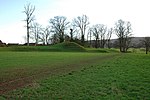Foxley is a rural estate, and the former Foxley Manor country seat, in Herefordshire, England. The Manor is associated with the judicial, political, artistic and later ennobled Price family, and became the site of the Second World War Foxley Camp.
Foxley estate, approximately 7 miles (11 km) north-west from the city and county town of Hereford, is mostly in the civil parish of Yazor, with the south-east part in Mansel Lacy, while also extending into parts of the parishes of Brinsop and Wormsley and Weobley. At the south-east border of Yazor parish, the former Foxley Manor house (SO4138046599), was centred on a 1 mile (1.6 km) radius between the village of Mansel Lacy at the south-east, and the largely depopulated settlements of Yazor at the west, Yarsop at the north-west, and Wormsley at the north-east.
The estate is within a south-east to north-west aligned horseshoe valley (alternatively named Yarsop Valley), of 1,600 yards (1,500 m) long by 1,300 yards (1,200 m) wide, with its main entrance in Mansel Lacy. The valley bottom rises from approximately 340 feet (104 m) above mean sea level at the south-east, to 510 feet (155 m) at the Foxley Manor (remains of) north-west end. Through the estate flows a stream, interrupted by seven c.1800 or earlier man-made lakes and ponds, starting at Yarsop, entering the valley at the north, and with largely wooded margins, flowing at the north and parallel to the main valley road, past a 240 feet (73 m) by 100 feet (30 m) pond (SO4158946686), between the stream and the Foxley Manor site, then flowing at the north around the remains of the Camp, past the site of an old saw mill (SO4204546416), before passing out of the estate to lakes and ponds in Mansel Lacy village. The sides of the valley are wooded, at the south-west by Nash Wood which rises to 610 feet (190 m), and north-east by Bache Wood, rising to 790 feet (240 m). Through the valley bottom runs a road, the former processional way from the estate entrance at Mansel Lacy village, north-west to the country house and ancillary buildings of the Manor, and beyond to the estate border at a junction with the minor road running south from Yarsop at the north to the A480 road at St Mary the Virgin's church in Yazor. Opposite St Mary's (SO4066046538), is the 1887-built gatehoused north-west road to the rear of the previous Foxley Manor house, which also links to a network of woodland bridle paths within the south-west Nash Wood. From the valley road, chiefly running north-east, are access roads and tracks to remaining estate and residential buildings and, bordering both sides of the road (SO4185046420), are concrete stands indicating the position of wartime Foxley Camp structures. Between these and Bache Wood at the north is the area previously designated "The Lawns" (SO4203446660), now converted to coppicing and arable use.Significant extant buildings of Foxley estate include the former 1860s stable block set around a courtyard 70 yards (64 m) north from the Foxley Manor remains. The stable block itself incorporates, on the south side, a c.1700 Grade II listed dovecot (SO4132946698). The two-storey dovecot dates to c.1700, but with 1868 alterations. Of octagonal-plan, it is of brick on a sandstone plinth, with a "tiled roof and wooden tiled lantern", with its entrance and principal side facing north-east into the stable block courtyard. The interior at the time of listing contained "many nesting holes and ledges". At 500 yards (460 m) south from the stable block, and in Nash Wood, is the listed Ragged Castle (SO4132846236), a trapezoidal-plan gazebo dating to 1743, with a restoration in 1975. The folly structure contains two flights of stairs and a roof with battlemented parapets. It was built to provide panoramic views, and as a memorial to the Davenport family. The gatehouse, Yazor Lodge, at the head of the drive opposite St Mary's church on the A480 was built to plans by William Chick (1829-1892), of Hereford in 1872.











